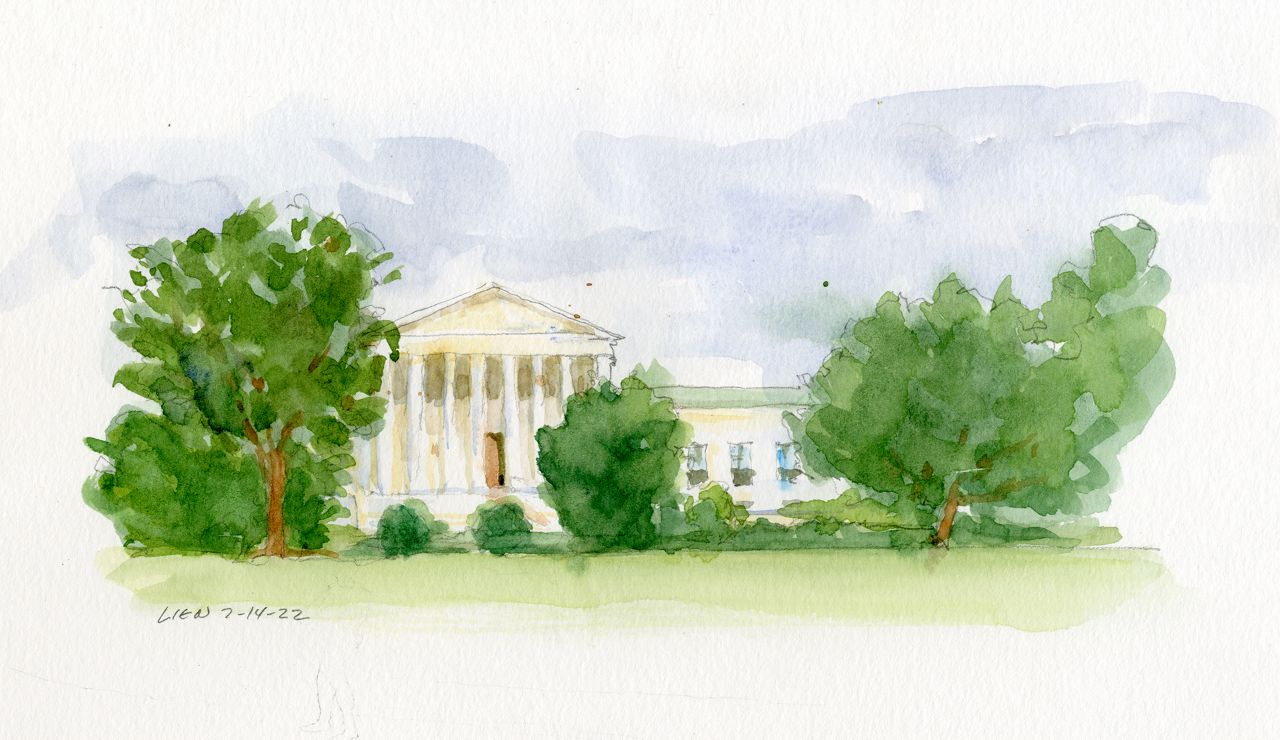For more than 40 years, Arthur "Art" Lien has gone where cameras cannot: Inside the hallowed halls of the United States Supreme Court.
But the well-known sketch artist, who has received a considerable amount of recognition for his work, is hanging up his pencils and brushes.
When Lien was twenty-five, he was laying sod and painting houses. It was definitely not the career the art school graduate had in mind.
“I started to really worry that this was it,” Lien, now 70, recalled to Spectrum News.
But he soon got an unexpected big break.
“Our governor in Maryland, Gov. [Marvin] Mandel was going on trial," he said. "And the local station was looking for somebody to sketch the trial. I answered the call."
Lien recalled that things did not go smoothly at first.
“I started out with [these] big sheets of non-absorbent paper, and I was using this opaque watercolo," Lien recalled. "And every time I tilted my drawing pad, everything would run."
"I was actually fired by my first day on the job because I did such a terrible job,” he added. “I called him up. I said, ‘let me go back. You don’t have to pay me, but I just, I think I know the problem.’ And they didn’t me back.”
Lien then moved on to a bigger court: The U.S. Supreme Court.

CBS News hired Lien to cover the court and the Senate in 1977 under their top artist, Howard Brodie, a World War II combat artist.
“He had just covered Watergate, and then the Manson trial and, he sort of took me under his wing and first took me over to the Supreme Court,” Lien recalled. “After the Supreme Court in the morning, we went over to the Senate. And it was all very overwhelming. I don’t think I actually finished one drawing that day. But I guess I showed some promise. So CBS hired me and that’s how I got my start here.”
Over time, Lien’s body of work continued to grow, covering the Oklahoma City and Boston Marathon Bombing trials, the Manafort trail and three presidential impeachment trials. But his main focus was the Supreme Court.
“I have loved it. I really have. The people I work with in the press room, I really feel very much at home there. I love that,” said Lien, as he sketched the exterior of the high court.
Lien has worked for CBS, NBC, and most recently SCOTUSblog, being the eyes inside the courtroom where cameras are not allowed. Though he is one of the nation’s top sketch artists, the 70-year-old is still humble when it comes to his craft.
“Really, I’m just trying to get to capture something," he said "Am I trying to capture the emotion? Of course, I’m trying to capture the action, the body language, the setting of the courtroom, but, you know, I’m just trying to get something that’s passable."
“I think drawing is a lot like storytelling, a lot like what a writer does," he added. "Much closer to that than a photographer, because I’m sort of compressing time and emphasizing certain things and compressing space as well.”
When the pandemic hit, everyone’s world was turned upside down. Court proceedings were being conducted remotely, including Supreme Court arguments, but it did not deter Lien. Instead, he got creative.
“I contacted all the lawyers that were arguing cases and asked them if they could send a photograph of themselves arguing in front of the speakerphone. And they did,” he saiid, with a laugh. He noted that some lawyers included memorabilia, family photos, and other momentos in their snapshots in the hopes they would would make it into Lien’s sketches.
But as the pandemic eased and courtrooms reopened, Lien was reluctant to resume the long commute from Baltimore to Washington, D.C., and then he decided it was time to retire his sketch pad.
“I’ve always been semi-retired. I mean, it’s not a full-time job here at the Supreme Court. So I have plenty of things going on. I have a big old house that needs a lot of work. I am very much into building and riding bicycles,” said Lien of what he plans to do in his new free time.
Looking back on his career, we asked him who was the most difficult for him to capture on paper.
“Justice [Sandra Day] O’Connor was definitely the most difficult,” Lien said immediately. “There wasn’t much change in the court until O’Connor came on the bench,” he explained. “I just never felt like I really captured her perfectly.”
He answered just as quickly when asked what his favorite was.
“Oh, that’s got to be [Justice Stephen] Breyer,” he said with a smile. “He’s wonderful, very, you know, wonderful body language and moving his hands around. And he asks these long questions with these long hybrid bald hypotheticals. So you have a lot of time to draw [him], and I’ve always enjoyed it.”
It’s not hyperbole to say there may never be another courtroom sketch artist like Art Lien.
“I have a lot of young artists contact me and say, ‘How do I get started as a courtroom artist?’ I just tell them, It’s a dying art,” said Lien emotionally. “More cameras, better graphics, more perp walks, things like that, and also just an attitude that, you know, this is kind of archaic.”
The work Art Lien has put out is memorable, capturing history where cameras cannot and words fail. He says he cherishes the time he spent covering the nation’s high court.
“I guess Lady Justice was my muse," he said, before turning his focus to finishing his sketch.
